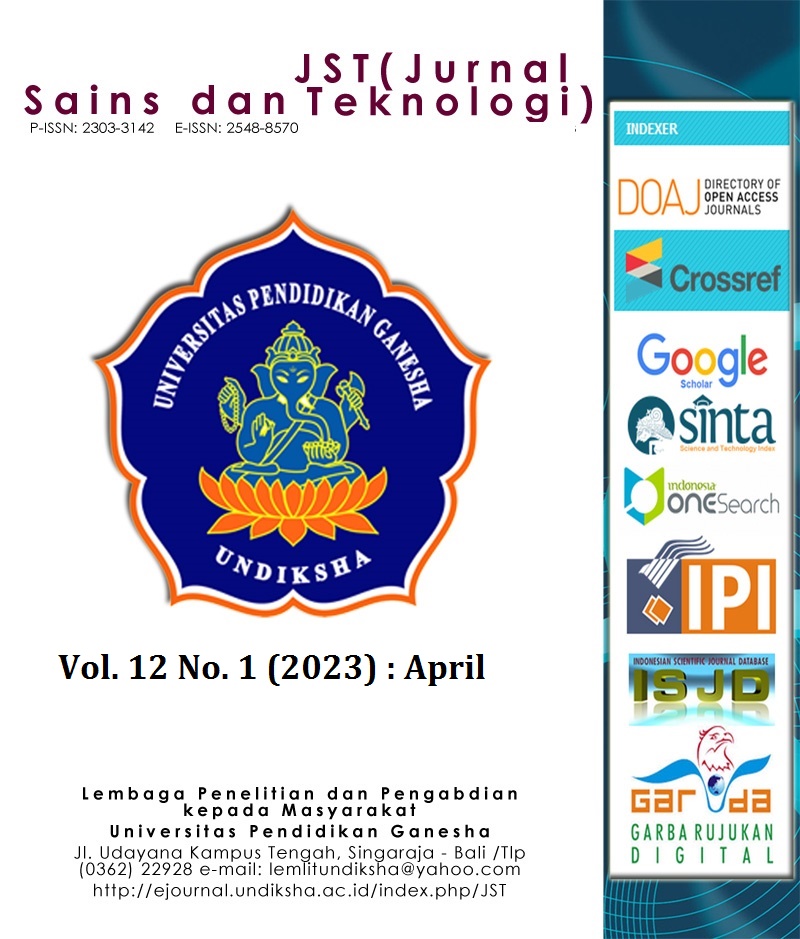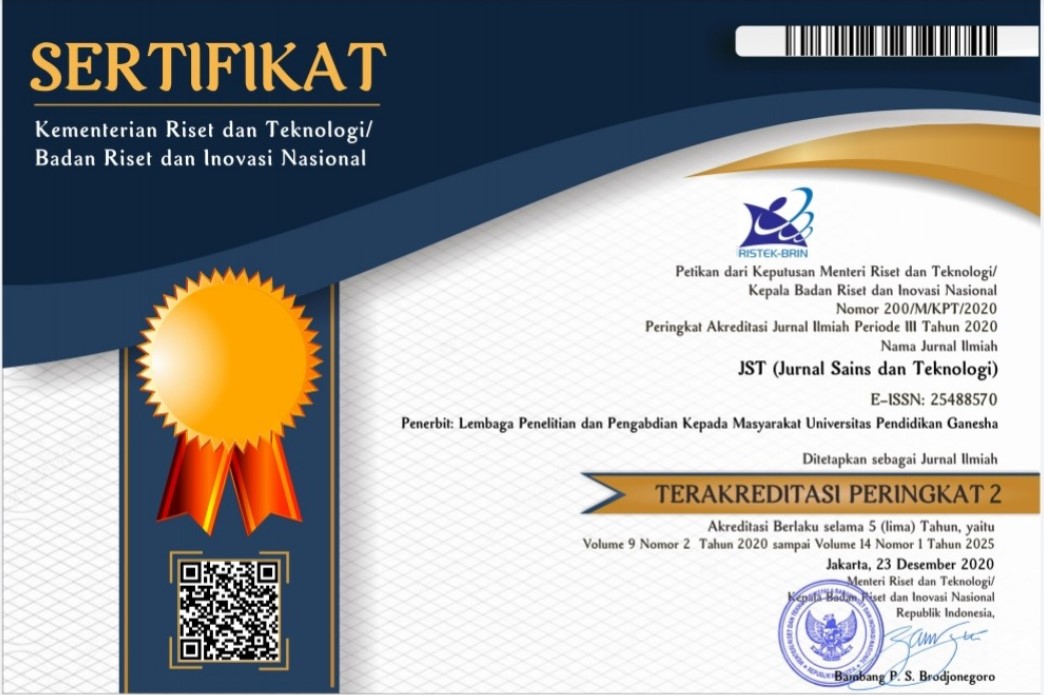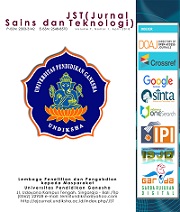Shoreline Changes for 20 Years (2001-2021) and 2041 Predictions and Adaptation of Coastal Communities
DOI:
https://doi.org/10.23887/jstundiksha.v12i1.53107Kata Kunci:
adaptasi, perubahan garis pantai, pesisir, Kota SemarangAbstrak
Shoreline alteration in Semarang continues to increase, causing abrasion, accretion, and tidal flooding yearly. Coastal damage has resulted in significant ecosystems in coastal areas losing their role in maintaining the stability of the coastline during the last two decades. This study aimed to analyse shoreline alterations from 2001 to 2021 and predict shoreline alterations over the following 20 years, together with alternative coastal community adaptations.
The analytical method employed DSAS 5.0 with an End Point Rate statistical approach for shoreline alterations; on the other hand, Linear Regression Rate analysis was utilised for 2041. Concerning coastal community adaptation, specifically through interviews. The study’s findings indicated that Semarang City experienced abrasion of approximately 10,31 m/year and accretion of approximately 20,95 m/year between 2001 and 2021. Abrasion and accretion will be slightly lower in 2041, at around 10,15 m/year and 19,69 m/year, respectively. The Protective and Accommodative Strategy is the proposed adaptation strategy for future changes.
Referensi
Bonnett, N., & Birchall, S. J. (2020). Coastal communities in the Circumpolar North and the need for sustainable climate adaptation approaches. Marine Policy, 121, 104175. https://doi.org/10.1016/j.marpol.2020.104175.
Bott, L.-M., & Braun, B. (2019). How do households respond to coastal hazards? A framework for accommodating strategies using the example of Semarang Bay, Indonesia. International Journal of Disaster Risk Reduction, 37, 101177. https://doi.org/10.1016/j.ijdrr.2019.101177.
Buchori, I., Pramitasari, A., Sugiri, A., Maryono, M., Basuki, Y., & Sejati, A. W. (2018). Adaptation to coastal flooding and inundation: mitigations and migration pattern in Semarang City, Indonesia. Ocean & Coastal Management, 163, 445–455. https://doi.org/10.1016/j.ocecoaman.2018.07.017.
Buchori, I., Sugiri, A., Mussadun, M., Wadley, D., Liu, Y., Pramitasari, A., & Pamungkas, I. T. D. (2018). A predictive model to assess spatial planning in addressing hydro-meteorological hazards: A case study of Semarang City, Indonesia. International Journal of Disaster Risk Reduction, 27, 415–426. https://doi.org/10.1016/j.ijdrr.2017.11.003.
Dewi, R. S. (2019). Monitoring long-term shoreline changes along the coast of Semarang. Earth and Environmental Science, 1(1), 1–9. https://doi.org/10.1088/1755-1315/284/1/012035.
Du, S., Scussolini, P., Ward, P. J., Zhang, M., Wen, J., Wang, L., … Ke, Q. (2020). Hard or soft flood adaptation? Advantages of a hybrid strategy for Shanghai. Global Environmental Change, 61, 102037. https://doi.org/10.1016/j.gloenvcha.2020.102037.
Fithor, A., Sutrisno, J., & Indarjo, A. (2018). Mangrove Ecosystem Management Strategy in Maron Beach Semarang. Indonesian Journal of Marine Sciences/Ilmu Kelautan, 23(4), 156–162. https://doi.org/10.14710/ik.ijms.23.4.156-162.
Fuad, M. A. Z., Yunita, N., Kasitowati, R. D., Hidayati, N., & Sartimbul, A. (2019). Pemantauan Perubahan Garis Pantai Jangka Panjang Dengan Teknologi Geospasial Di Pesisir Bagian Barat Kabupaten Tuban, Jawa Timur. Jurnal Geografi, 11(1), 48–61. https://doi.org/10.24114/jg.v11i1.11409.
Jonah, F. E., Boateng, I., Osman, A., Shimba, M. J., Mensah, E. A., Adu-Boahen, K., … Effah, E. (2016). Shoreline change analysis using end point rate and net shoreline movement statistics: An application to Elmina, Cape Coast and Moree section of Ghana’s coast. Regional Studies in Marine Science, 7, 19–31. https://doi.org/10.1016/j.rsma.2016.05.003.
Ling, T.-Y., & Chiang, Y.-C. (2018). Strengthening the resilience of urban retailers towards flood risks-A case study in the riverbank region of Kaohsiung City. International Journal of Disaster Risk Reduction, 27, 541–555. https://doi.org/10.1016/j.ijdrr.2017.11.020.
Marfai, M. A., Rahayu, E., & Triyanti, A. (2022). Peran kearifan lokal dan modal sosial dalam pengurangan risiko bencana dan pembangunan pesisir. Yogyakarta: Gajah Mada University Press.
Marques, J. N., & Khakhim, N. (2016). Kajian perubahan garis pantai menggunakan citra landsat multitemporal di Kota Semarang. Jurnal Bumi Indonesia, 5(2), 1–10.
Nassar, K., Mahmod, W. E., Fath, H., Masria, A., Nadaoka, K., & Negm, A. (2019). Shoreline change detection using DSAS technique: Case of North Sinai coast, Egypt. Marine Georesources & Geotechnology, 37(1), 81–95. https://doi.org/10.1080/1064119X.2018.1448912.
Navarro, O., Mambet, C., Barbaras, C., Chadenas, C., Robin, M., Chotard, M., … Fleury-Bahi, G. (2021). Determinant factors of protective behaviors regarding erosion and coastal flooding risk. International Journal of Disaster Risk Reduction, 61, 102378. https://doi.org/10.1016/j.ijdrr.2021.102378.
Ndour, A., Laïbi, R. A., Sadio, M., Degbe, C. G. E., Diaw, A. T., Oyédé, L. M., … Dussouillez, P. (2018). Management strategies for coastal erosion problems in West Africa: Analysis, issues, and Constraints drawn from the examples of Senegal and Benin. Ocean & Coastal Management, 156, 92–106. https://doi.org/10.1016/j.ocecoaman.2017.09.001.
Nikkanen, M., Räsänen, A., & Juhola, S. (2021). The influence of socioeconomic factors on storm preparedness and experienced impacts in Finland. International Journal of Disaster Risk Reduction, 55, 102089. https://doi.org/10.1016/j.ijdrr.2021.102089.
Prabowo, D., Muskananfola, M. R., & Purwanti, F. (2018). Analisis kerentanan Pantai Maroon dan Pantai Tirang, Kecamatan Tugu, Kota Semarang. Management of Aquatic Resources Journal (MAQUARES), 6(4), 555–563. https://doi.org/10.14710/marj.v6i4.21348.
Ruiz-Beltran, A. P., Astorga-Moar, A., Salles, P., & Appendini, C. M. (2019). Short-term shoreline trend detection patterns using SPOT-5 image fusion in the northwest of Yucatan, Mexico. Estuaries and Coasts, 42(7), 1761–1773. https://doi.org/10.1007/ s12237- 019- 00573- 7.
Sardiyatmo, Supriharyono, & Hartoko, A. (2013). Dampak dinamika garis pantai menggunakan citra satelit multi temporal Pantai Semarang Provinsi Jawa Tengah. Jurnal Saintek Perikanan, 8(2), 33–37. https://doi.org/10.14710/ijfst.8.2.33-37.
Setiadi, R., & Frederika, R. (2022). Family financial planning for disaster preparedness: A case study of north Semarang, Indonesia. International Journal of Disaster Risk Reduction, 82, 103332. https://doi.org/10.1016/j.ijdrr.2022.103332.
Suhelmi, I. R., & Triwibowo, H. (2018). Coastal inundation adaptive strategy in Semarang Coastal Area. In Forum Geografi (Vol. 32, pp. 195–203). https://doi.org/10.23917/forgeo.v31i2.5672.
Supriadi, E., Nurhalimah, N., & Bisri, K. (2020). Adaptation and Forms of Social Capital of Coastal Communities in Environmental Preservation. MIMBAR: Jurnal Sosial Dan Pembangunan, 36(2), 280–287. https://doi.org/10.29313/mimbar.v36i2.5491.
Syamsurizal, I., Patria, M. P., Koestoer, R. H. S., & Harmantyo, D. (2020). A conceptual model for Semarang City sustainability. In International Conference on Environmental Science and Sustainable Development (ICESSD). https://doi.org/10.4108/eai.22-10-2019.2291484.
Takagi, H., Esteban, M., Mikami, T., & Fujii, D. (2016). Projection of coastal floods in 2050 Jakarta. Urban Climate, 17, 135–145. https://doi.org/10.1016/j.uclim.2016.05.003.
Wibawa, E. A., Wahyudi, & Sambodho, K. (2012). Studi naiknya muka air laut di kawasan pesisir Semarang. Jurnal Teknik Kelautan, 1–10.
Zeinali, S., Talebbeydokhti, N., & Dehghani, M. (2020). Spatiotemporal shoreline change in Boushehr Province coasts, Iran. Journal of Oceanology and Limnology, 38(3), 707–721. https://doi.org/10.1007/s00343-019-8373-9.
Unduhan
Diterbitkan
Cara Mengutip
Terbitan
Bagian
Lisensi
Hak Cipta (c) 2022 Febrianti Amalia

Artikel ini berlisensiCreative Commons Attribution-ShareAlike 4.0 International License.
Authors who publish with the Jurnal Sains dan Teknologi (JST) agree to the following terms:
- Authors retain copyright and grant the journal the right of first publication with the work simultaneously licensed under a Creative Commons Attribution License (CC BY-SA 4.0) that allows others to share the work with an acknowledgment of the work's authorship and initial publication in this journal.
- Authors are able to enter into separate, additional contractual arrangements for the non-exclusive distribution of the journal's published version of the work (e.g., post it to an institutional repository or publish it in a book), with an acknowledgment of its initial publication in this journal.
- Authors are permitted and encouraged to post their work online (e.g., in institutional repositories or on their website) prior to and during the submission process, as it can lead to productive exchanges, as well as earlier and greater citation of published work. (See The Effect of Open Access)
















